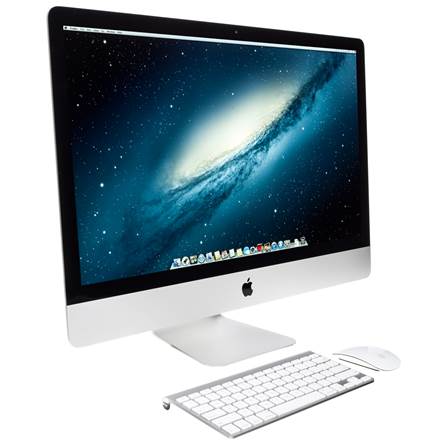As Apple‘s previous decade-old Mac Pro began to flag the
27in iMac took over as the model of choice for creative professionals. The
21.5in option is great value for everyone else offering more than adequate performance
and an excellent screen.
Features
Made from one huge chunk of aluminium and fronted with
edge-to-edge glass, the iMac is all the more imposing for the blade-like
thinness of its edges. It bulges at the back to accommodate the components
inside, but that's visible from surprisingly few angles. This is a Mac that
will enhance any room it’s installed in wall-mounting is possible, but only with
a dedicated VESA model, which you need to order specifically.

iMac 27in
iMacs are fairly quiet, but in processor-intensive tasks you’ll
hear a background whoosh from the fans that suck air from the bottom edge and
push it out of the back The case can also get very warm in parts; this is one
of the ways the machine dissipates heat.
Pros and cons
The iMac covers a wide range of specifications. Your first choice
is between 21.5 and 27in. The smaller screen is more than adequate, offering
1920 x 1080 Full HD resolution, 27in may not sound much bigger, but at 2560 x
1440 you have over 75% more pixels to play with, which makes a big difference
to work tasks. Video editing and page layout are much more comfortable at this
size, and you can more easily arrange multiple documents to view and edit
together.

The iMac's two thunderbolt ports are of the
original 10Gbit/ sec specifications, not the Mac pro's 20gbit/ sec Thunderbolt
2. There are 4 USB 3 ports, one Gigabit Ethernet port, an SD card slot and a
combined optical and analogue audio output.
If you need even more room, each iMac can also drive an external
display up to 2560 x 1600, extending the desktop across both screens. This has
to be connected via Thunderbolt (directly to an Apple Thunderbolt Display or
any DisplayPort monitor; or with an adaptor to monitors with other interfaces);
the iMac has no HDMI port. As with other Macs running OS X 10.9 Mavericks, however,
you can add a display wirelessly via AirPlay with an Apple TV. You can use an
iMac as a monitor for another Thunderbolt Mac, but only by restarting it in
Target Display Mode.
Note that the 21.5in has fewer built- to-order options: the
maximum hard disk or Fusion Drive is 1TB, compared to 3TB for the 27in, and the
maximum RAM is 16GB rather than 32GB.
Performance
Every standard iMac configuration features a fast Core i5 processor.
Core i7 options, available to order from Apple, help with intensive tasks such
as CPU- based video encoding and keep things running smoothly if you use
virtualisation to run Windows apps within OS X.
The entry-level 21.5in iMac has Intel’s Iris Pro integrated
graphics, which gave us a decent 38.7 frames per second in Cinebench’s OpenG L
test. The top 27in configuration’s GT 775M GPU storms ahead of that with
88.4fps, and you still have the option of the 780M, which gives 104fps. For
work that relies heavily on graphics, it’s worth going straight to the top of
the iMac table, although it does push the price over $3,299.

The 27in iMac has a hatch behind its stand to
access the RAM slots; you can install up to 32GB. On the 25.1in model, adding
RAM is a job for a patient engineer, so aim to get as much as you're likely to
need when you order your machine
In real-world use, the Iris Pro is respectable for gaming, with a
median of 45fps and a minimum of 35fps in Batman: Arkham City. The most affordable
2'fin still struggles to run this at its native 2560 x 1440 pixels, so you may
have to lower the resolution to keep games above 3ofps - but remember you’re
starting from a resolution next-generation games consoles can’t offer! The
higher 21.5in model has a slightly less capable GT 75oM. The 78oM gives the
best performance short of a Mac Pro, with 41-62fps in Arkham City.
The iMac’s Achilles heel is its hard disk, which makes general
operation feel slow compared to SSD-based Macs. If you can, pay the extra $263.93-$461.86
for a Fusion Drive, which combines 128GB of flash memory with a hard disk for
vastly increased performance. You can also go full SSD, as with the MacBook Air
and Retina, but this costs a lot more for less storage. Adding an external SSD
via USB 3 or Thunderbolt is a good option if you want the quickest storage without
breaking the bank.